Financial Accounting: Analysis of Financial Reporting & Disclosure
VerifiedAdded on 2023/06/12
|11
|2927
|314
Report
AI Summary
This report provides a detailed analysis of financial accounting principles, focusing on the significance of financial statements, the application of AASB 101 and AASB 108, and the importance of accounting disclosure. It addresses issues related to financial instruments, assets, and liabilities, as well as the use of derivatives. The report also examines the role of financial statements in providing reliable information to investors and stakeholders, emphasizing the need for clarity and conciseness in financial reporting. It concludes that proper application of accounting standards and transparent disclosures are essential for maintaining the quality and reliability of financial information, enabling informed economic decisions. Desklib offers a wealth of similar solved assignments and study resources for students.
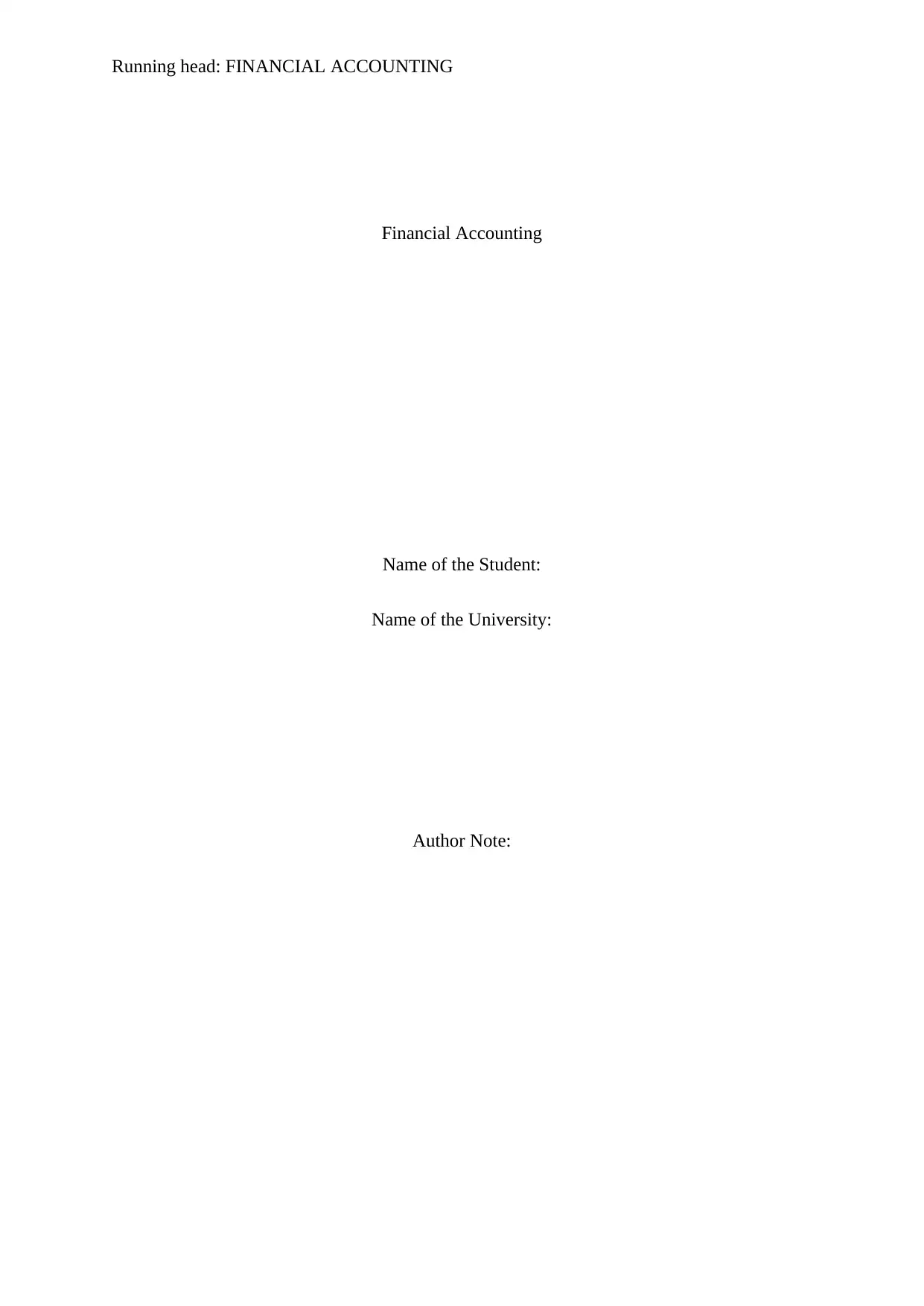
Running head: FINANCIAL ACCOUNTING
Financial Accounting
Name of the Student:
Name of the University:
Author Note:
Financial Accounting
Name of the Student:
Name of the University:
Author Note:
Paraphrase This Document
Need a fresh take? Get an instant paraphrase of this document with our AI Paraphraser
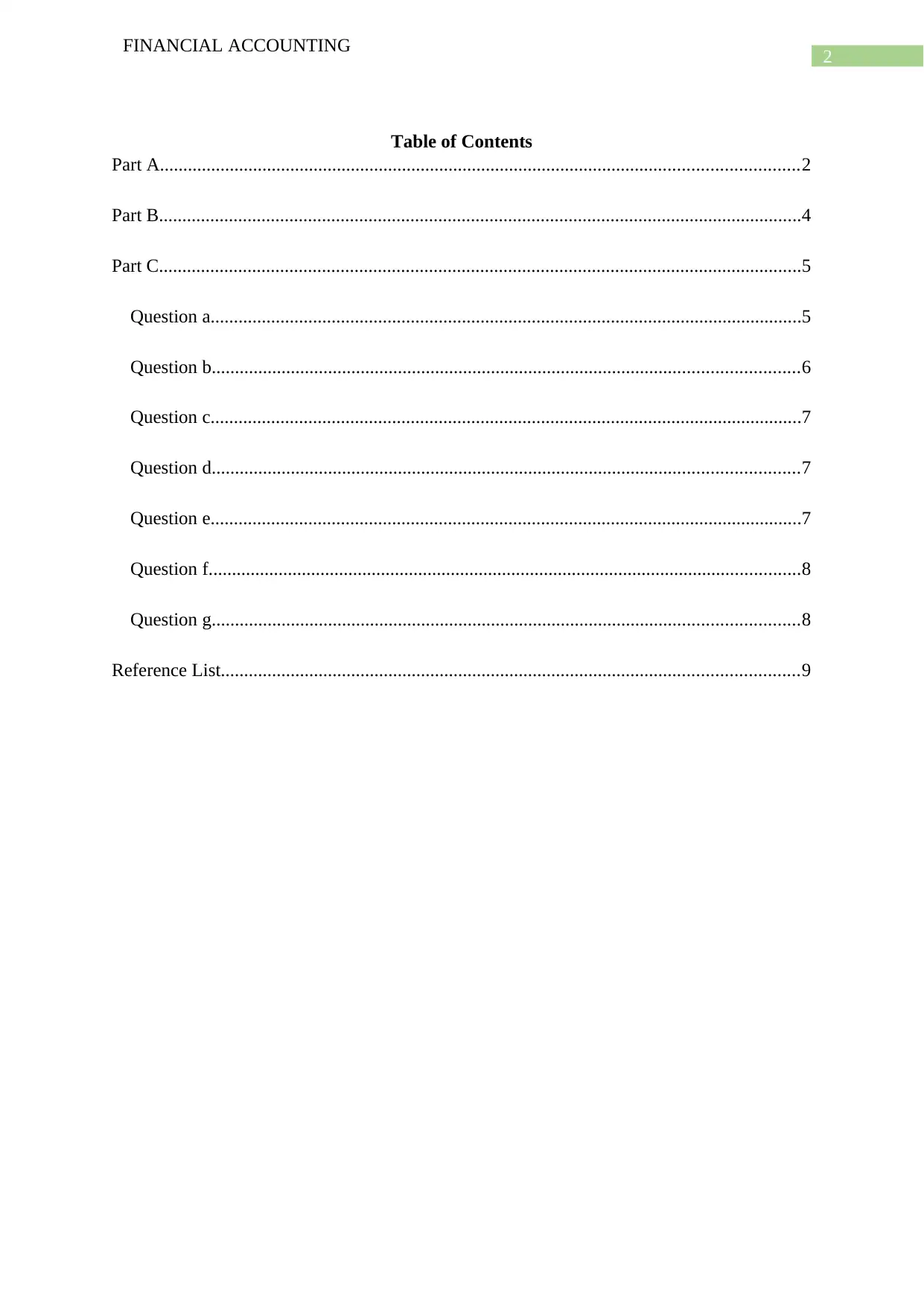
2
FINANCIAL ACCOUNTING
Table of Contents
Part A.........................................................................................................................................2
Part B..........................................................................................................................................4
Part C..........................................................................................................................................5
Question a...............................................................................................................................5
Question b..............................................................................................................................6
Question c...............................................................................................................................7
Question d..............................................................................................................................7
Question e...............................................................................................................................7
Question f...............................................................................................................................8
Question g..............................................................................................................................8
Reference List............................................................................................................................9
FINANCIAL ACCOUNTING
Table of Contents
Part A.........................................................................................................................................2
Part B..........................................................................................................................................4
Part C..........................................................................................................................................5
Question a...............................................................................................................................5
Question b..............................................................................................................................6
Question c...............................................................................................................................7
Question d..............................................................................................................................7
Question e...............................................................................................................................7
Question f...............................................................................................................................8
Question g..............................................................................................................................8
Reference List............................................................................................................................9
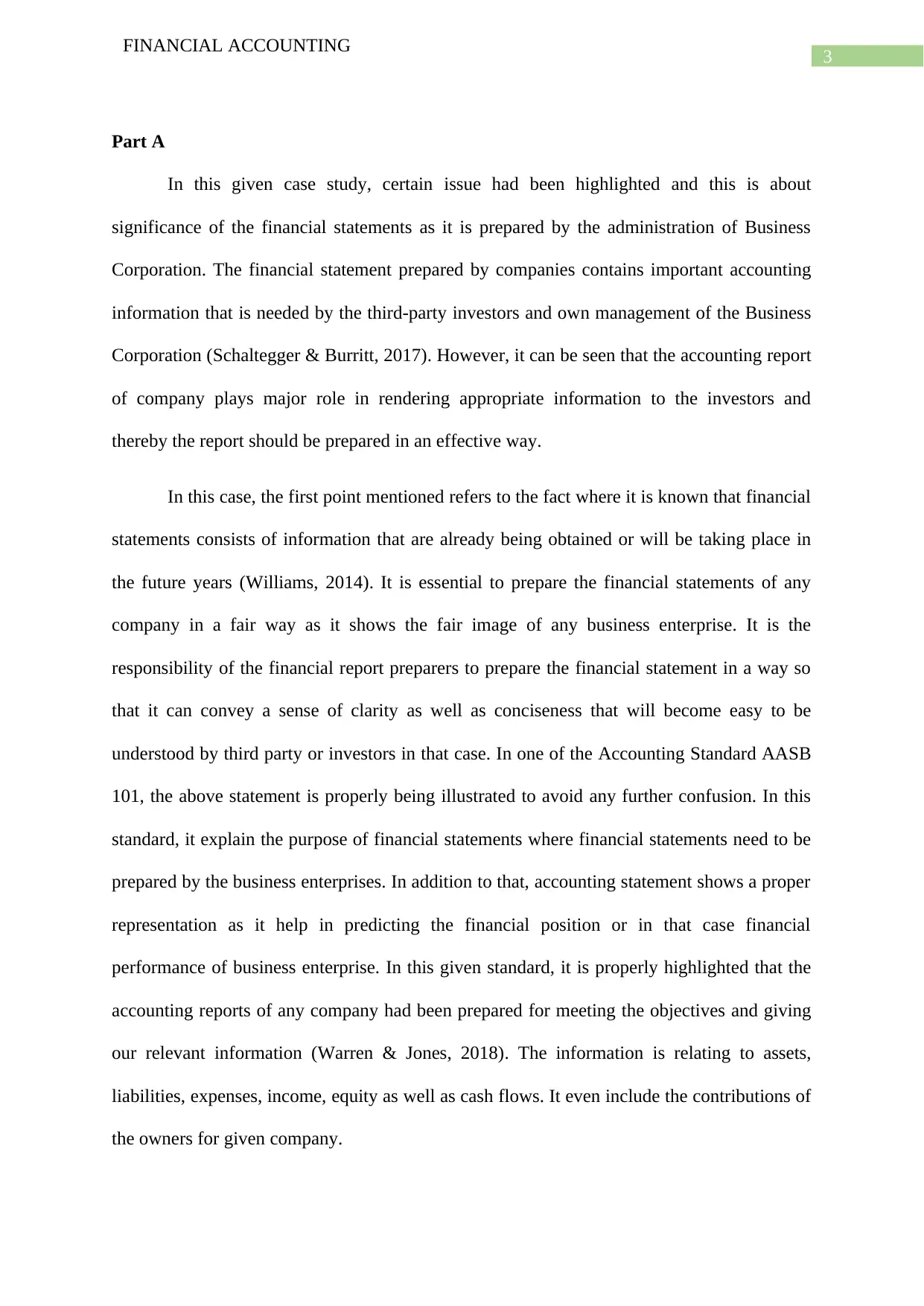
3
FINANCIAL ACCOUNTING
Part A
In this given case study, certain issue had been highlighted and this is about
significance of the financial statements as it is prepared by the administration of Business
Corporation. The financial statement prepared by companies contains important accounting
information that is needed by the third-party investors and own management of the Business
Corporation (Schaltegger & Burritt, 2017). However, it can be seen that the accounting report
of company plays major role in rendering appropriate information to the investors and
thereby the report should be prepared in an effective way.
In this case, the first point mentioned refers to the fact where it is known that financial
statements consists of information that are already being obtained or will be taking place in
the future years (Williams, 2014). It is essential to prepare the financial statements of any
company in a fair way as it shows the fair image of any business enterprise. It is the
responsibility of the financial report preparers to prepare the financial statement in a way so
that it can convey a sense of clarity as well as conciseness that will become easy to be
understood by third party or investors in that case. In one of the Accounting Standard AASB
101, the above statement is properly being illustrated to avoid any further confusion. In this
standard, it explain the purpose of financial statements where financial statements need to be
prepared by the business enterprises. In addition to that, accounting statement shows a proper
representation as it help in predicting the financial position or in that case financial
performance of business enterprise. In this given standard, it is properly highlighted that the
accounting reports of any company had been prepared for meeting the objectives and giving
our relevant information (Warren & Jones, 2018). The information is relating to assets,
liabilities, expenses, income, equity as well as cash flows. It even include the contributions of
the owners for given company.
FINANCIAL ACCOUNTING
Part A
In this given case study, certain issue had been highlighted and this is about
significance of the financial statements as it is prepared by the administration of Business
Corporation. The financial statement prepared by companies contains important accounting
information that is needed by the third-party investors and own management of the Business
Corporation (Schaltegger & Burritt, 2017). However, it can be seen that the accounting report
of company plays major role in rendering appropriate information to the investors and
thereby the report should be prepared in an effective way.
In this case, the first point mentioned refers to the fact where it is known that financial
statements consists of information that are already being obtained or will be taking place in
the future years (Williams, 2014). It is essential to prepare the financial statements of any
company in a fair way as it shows the fair image of any business enterprise. It is the
responsibility of the financial report preparers to prepare the financial statement in a way so
that it can convey a sense of clarity as well as conciseness that will become easy to be
understood by third party or investors in that case. In one of the Accounting Standard AASB
101, the above statement is properly being illustrated to avoid any further confusion. In this
standard, it explain the purpose of financial statements where financial statements need to be
prepared by the business enterprises. In addition to that, accounting statement shows a proper
representation as it help in predicting the financial position or in that case financial
performance of business enterprise. In this given standard, it is properly highlighted that the
accounting reports of any company had been prepared for meeting the objectives and giving
our relevant information (Warren & Jones, 2018). The information is relating to assets,
liabilities, expenses, income, equity as well as cash flows. It even include the contributions of
the owners for given company.
⊘ This is a preview!⊘
Do you want full access?
Subscribe today to unlock all pages.

Trusted by 1+ million students worldwide
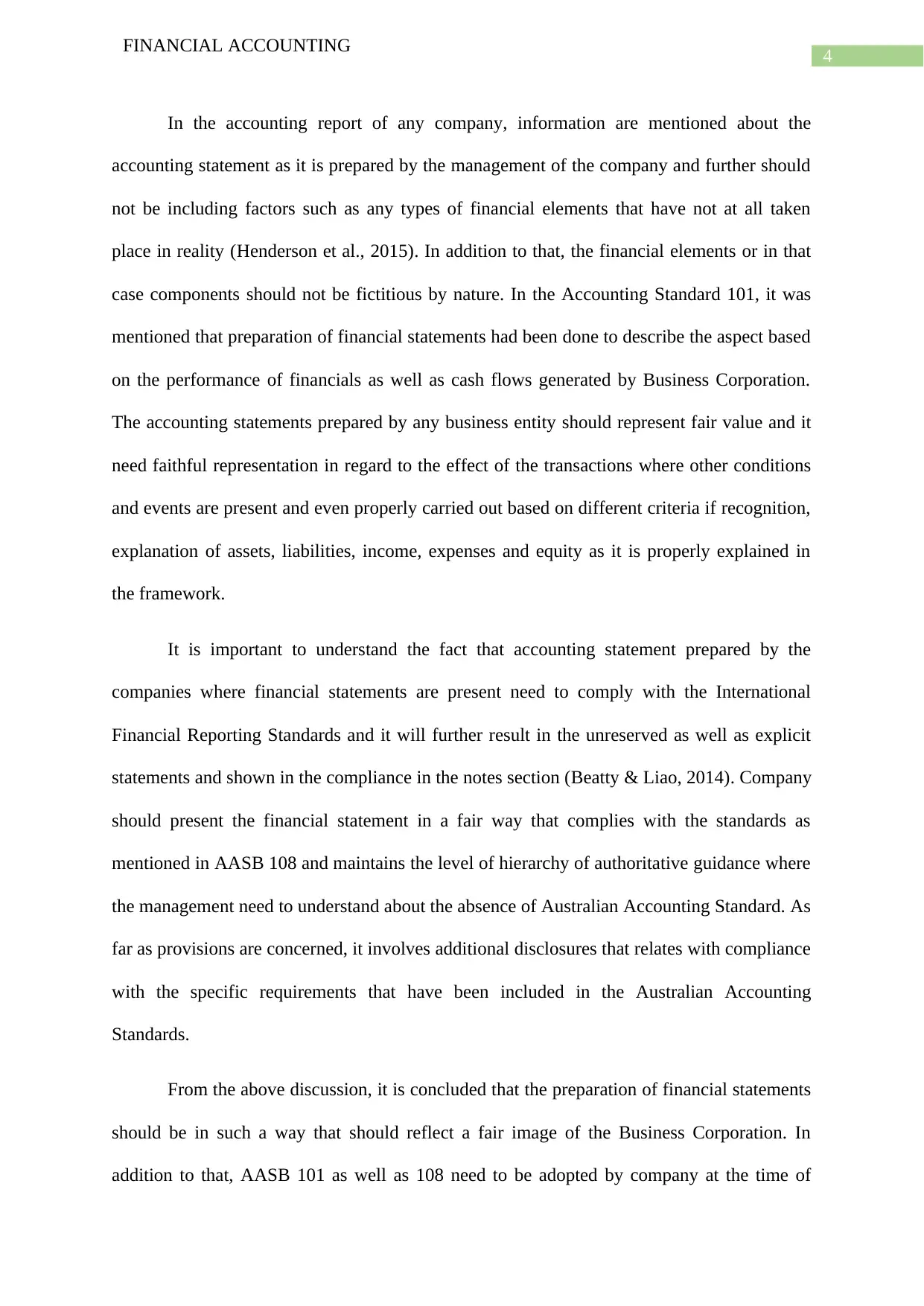
4
FINANCIAL ACCOUNTING
In the accounting report of any company, information are mentioned about the
accounting statement as it is prepared by the management of the company and further should
not be including factors such as any types of financial elements that have not at all taken
place in reality (Henderson et al., 2015). In addition to that, the financial elements or in that
case components should not be fictitious by nature. In the Accounting Standard 101, it was
mentioned that preparation of financial statements had been done to describe the aspect based
on the performance of financials as well as cash flows generated by Business Corporation.
The accounting statements prepared by any business entity should represent fair value and it
need faithful representation in regard to the effect of the transactions where other conditions
and events are present and even properly carried out based on different criteria if recognition,
explanation of assets, liabilities, income, expenses and equity as it is properly explained in
the framework.
It is important to understand the fact that accounting statement prepared by the
companies where financial statements are present need to comply with the International
Financial Reporting Standards and it will further result in the unreserved as well as explicit
statements and shown in the compliance in the notes section (Beatty & Liao, 2014). Company
should present the financial statement in a fair way that complies with the standards as
mentioned in AASB 108 and maintains the level of hierarchy of authoritative guidance where
the management need to understand about the absence of Australian Accounting Standard. As
far as provisions are concerned, it involves additional disclosures that relates with compliance
with the specific requirements that have been included in the Australian Accounting
Standards.
From the above discussion, it is concluded that the preparation of financial statements
should be in such a way that should reflect a fair image of the Business Corporation. In
addition to that, AASB 101 as well as 108 need to be adopted by company at the time of
FINANCIAL ACCOUNTING
In the accounting report of any company, information are mentioned about the
accounting statement as it is prepared by the management of the company and further should
not be including factors such as any types of financial elements that have not at all taken
place in reality (Henderson et al., 2015). In addition to that, the financial elements or in that
case components should not be fictitious by nature. In the Accounting Standard 101, it was
mentioned that preparation of financial statements had been done to describe the aspect based
on the performance of financials as well as cash flows generated by Business Corporation.
The accounting statements prepared by any business entity should represent fair value and it
need faithful representation in regard to the effect of the transactions where other conditions
and events are present and even properly carried out based on different criteria if recognition,
explanation of assets, liabilities, income, expenses and equity as it is properly explained in
the framework.
It is important to understand the fact that accounting statement prepared by the
companies where financial statements are present need to comply with the International
Financial Reporting Standards and it will further result in the unreserved as well as explicit
statements and shown in the compliance in the notes section (Beatty & Liao, 2014). Company
should present the financial statement in a fair way that complies with the standards as
mentioned in AASB 108 and maintains the level of hierarchy of authoritative guidance where
the management need to understand about the absence of Australian Accounting Standard. As
far as provisions are concerned, it involves additional disclosures that relates with compliance
with the specific requirements that have been included in the Australian Accounting
Standards.
From the above discussion, it is concluded that the preparation of financial statements
should be in such a way that should reflect a fair image of the Business Corporation. In
addition to that, AASB 101 as well as 108 need to be adopted by company at the time of
Paraphrase This Document
Need a fresh take? Get an instant paraphrase of this document with our AI Paraphraser
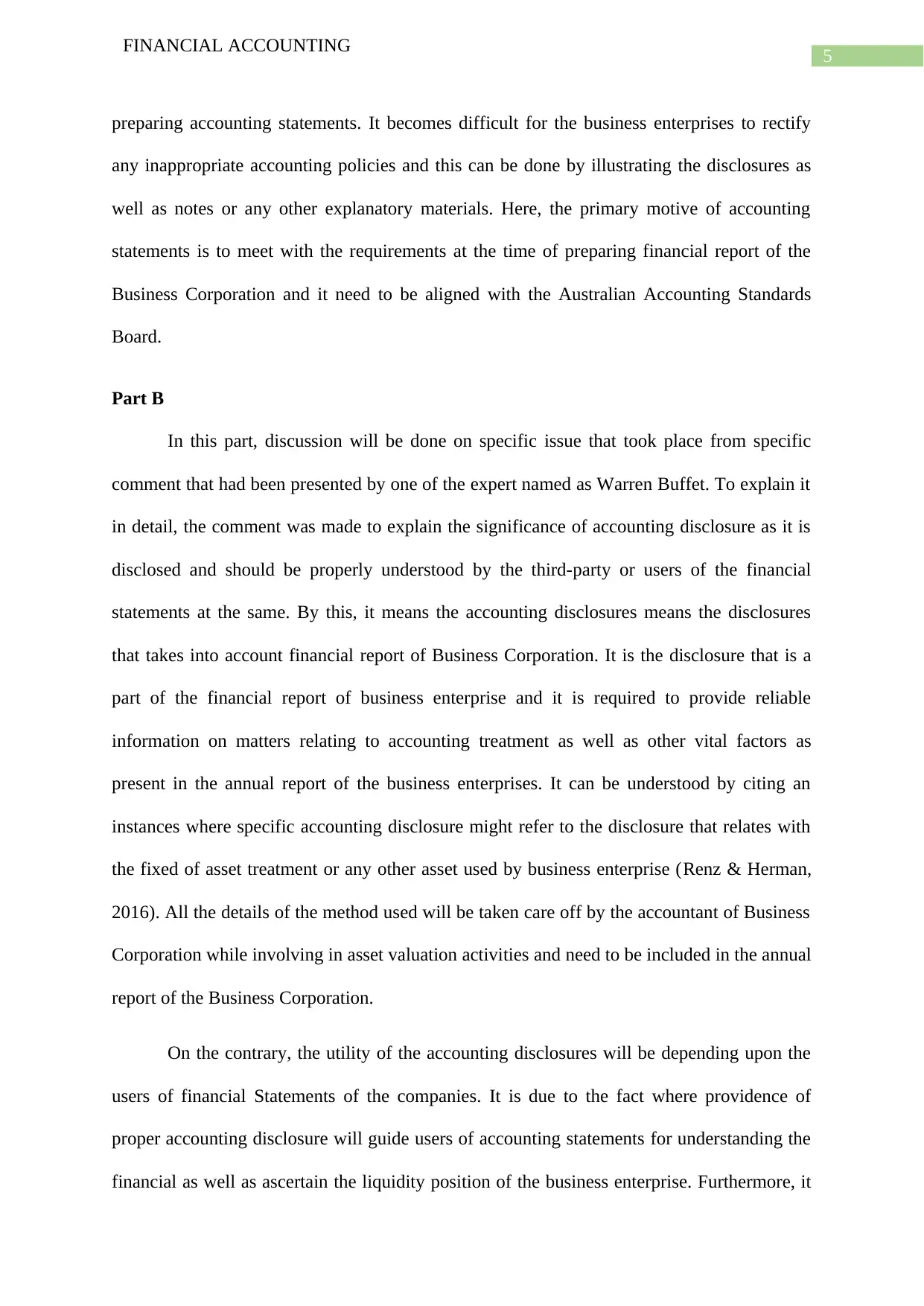
5
FINANCIAL ACCOUNTING
preparing accounting statements. It becomes difficult for the business enterprises to rectify
any inappropriate accounting policies and this can be done by illustrating the disclosures as
well as notes or any other explanatory materials. Here, the primary motive of accounting
statements is to meet with the requirements at the time of preparing financial report of the
Business Corporation and it need to be aligned with the Australian Accounting Standards
Board.
Part B
In this part, discussion will be done on specific issue that took place from specific
comment that had been presented by one of the expert named as Warren Buffet. To explain it
in detail, the comment was made to explain the significance of accounting disclosure as it is
disclosed and should be properly understood by the third-party or users of the financial
statements at the same. By this, it means the accounting disclosures means the disclosures
that takes into account financial report of Business Corporation. It is the disclosure that is a
part of the financial report of business enterprise and it is required to provide reliable
information on matters relating to accounting treatment as well as other vital factors as
present in the annual report of the business enterprises. It can be understood by citing an
instances where specific accounting disclosure might refer to the disclosure that relates with
the fixed of asset treatment or any other asset used by business enterprise (Renz & Herman,
2016). All the details of the method used will be taken care off by the accountant of Business
Corporation while involving in asset valuation activities and need to be included in the annual
report of the Business Corporation.
On the contrary, the utility of the accounting disclosures will be depending upon the
users of financial Statements of the companies. It is due to the fact where providence of
proper accounting disclosure will guide users of accounting statements for understanding the
financial as well as ascertain the liquidity position of the business enterprise. Furthermore, it
FINANCIAL ACCOUNTING
preparing accounting statements. It becomes difficult for the business enterprises to rectify
any inappropriate accounting policies and this can be done by illustrating the disclosures as
well as notes or any other explanatory materials. Here, the primary motive of accounting
statements is to meet with the requirements at the time of preparing financial report of the
Business Corporation and it need to be aligned with the Australian Accounting Standards
Board.
Part B
In this part, discussion will be done on specific issue that took place from specific
comment that had been presented by one of the expert named as Warren Buffet. To explain it
in detail, the comment was made to explain the significance of accounting disclosure as it is
disclosed and should be properly understood by the third-party or users of the financial
statements at the same. By this, it means the accounting disclosures means the disclosures
that takes into account financial report of Business Corporation. It is the disclosure that is a
part of the financial report of business enterprise and it is required to provide reliable
information on matters relating to accounting treatment as well as other vital factors as
present in the annual report of the business enterprises. It can be understood by citing an
instances where specific accounting disclosure might refer to the disclosure that relates with
the fixed of asset treatment or any other asset used by business enterprise (Renz & Herman,
2016). All the details of the method used will be taken care off by the accountant of Business
Corporation while involving in asset valuation activities and need to be included in the annual
report of the Business Corporation.
On the contrary, the utility of the accounting disclosures will be depending upon the
users of financial Statements of the companies. It is due to the fact where providence of
proper accounting disclosure will guide users of accounting statements for understanding the
financial as well as ascertain the liquidity position of the business enterprise. Furthermore, it
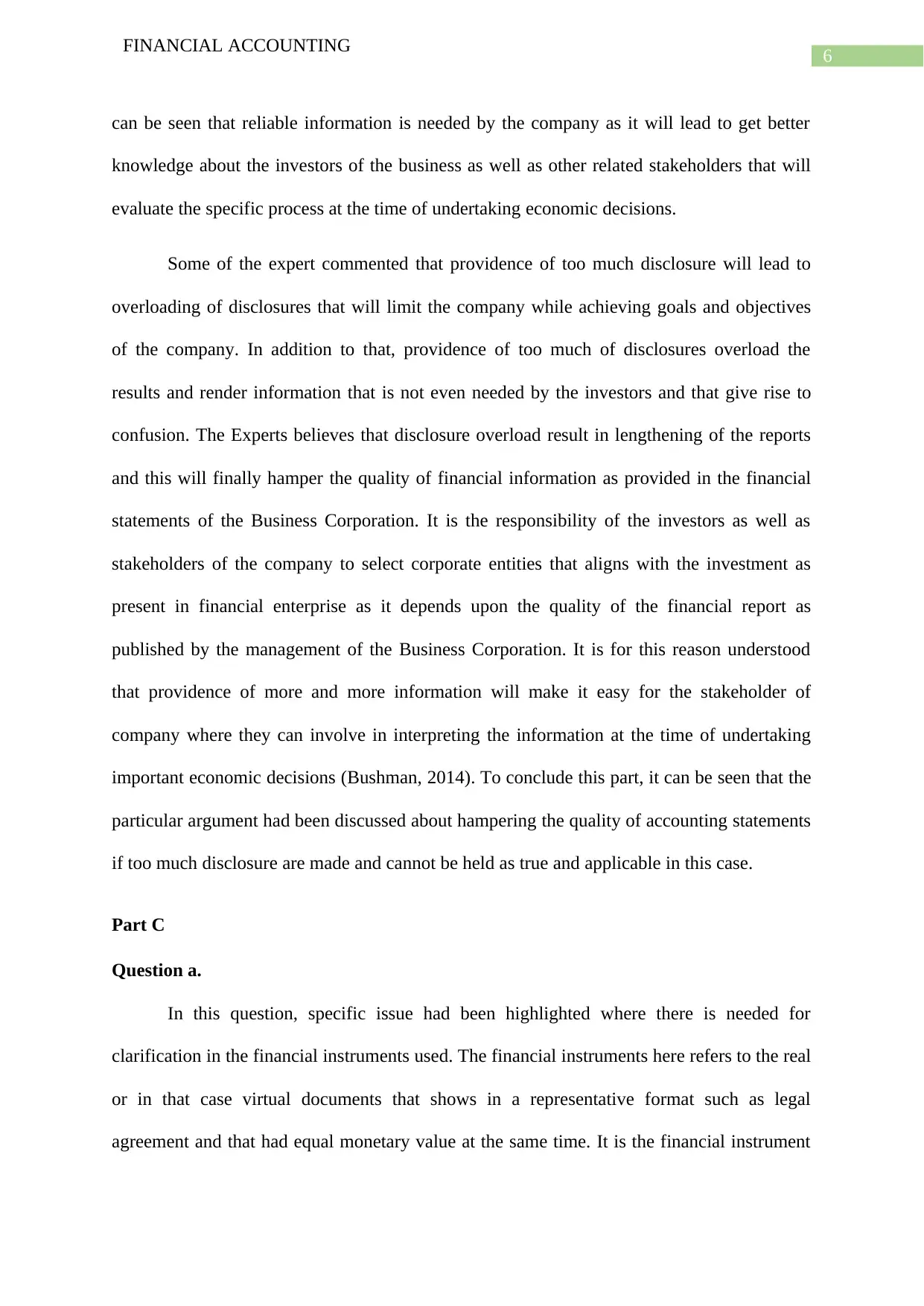
6
FINANCIAL ACCOUNTING
can be seen that reliable information is needed by the company as it will lead to get better
knowledge about the investors of the business as well as other related stakeholders that will
evaluate the specific process at the time of undertaking economic decisions.
Some of the expert commented that providence of too much disclosure will lead to
overloading of disclosures that will limit the company while achieving goals and objectives
of the company. In addition to that, providence of too much of disclosures overload the
results and render information that is not even needed by the investors and that give rise to
confusion. The Experts believes that disclosure overload result in lengthening of the reports
and this will finally hamper the quality of financial information as provided in the financial
statements of the Business Corporation. It is the responsibility of the investors as well as
stakeholders of the company to select corporate entities that aligns with the investment as
present in financial enterprise as it depends upon the quality of the financial report as
published by the management of the Business Corporation. It is for this reason understood
that providence of more and more information will make it easy for the stakeholder of
company where they can involve in interpreting the information at the time of undertaking
important economic decisions (Bushman, 2014). To conclude this part, it can be seen that the
particular argument had been discussed about hampering the quality of accounting statements
if too much disclosure are made and cannot be held as true and applicable in this case.
Part C
Question a.
In this question, specific issue had been highlighted where there is needed for
clarification in the financial instruments used. The financial instruments here refers to the real
or in that case virtual documents that shows in a representative format such as legal
agreement and that had equal monetary value at the same time. It is the financial instrument
FINANCIAL ACCOUNTING
can be seen that reliable information is needed by the company as it will lead to get better
knowledge about the investors of the business as well as other related stakeholders that will
evaluate the specific process at the time of undertaking economic decisions.
Some of the expert commented that providence of too much disclosure will lead to
overloading of disclosures that will limit the company while achieving goals and objectives
of the company. In addition to that, providence of too much of disclosures overload the
results and render information that is not even needed by the investors and that give rise to
confusion. The Experts believes that disclosure overload result in lengthening of the reports
and this will finally hamper the quality of financial information as provided in the financial
statements of the Business Corporation. It is the responsibility of the investors as well as
stakeholders of the company to select corporate entities that aligns with the investment as
present in financial enterprise as it depends upon the quality of the financial report as
published by the management of the Business Corporation. It is for this reason understood
that providence of more and more information will make it easy for the stakeholder of
company where they can involve in interpreting the information at the time of undertaking
important economic decisions (Bushman, 2014). To conclude this part, it can be seen that the
particular argument had been discussed about hampering the quality of accounting statements
if too much disclosure are made and cannot be held as true and applicable in this case.
Part C
Question a.
In this question, specific issue had been highlighted where there is needed for
clarification in the financial instruments used. The financial instruments here refers to the real
or in that case virtual documents that shows in a representative format such as legal
agreement and that had equal monetary value at the same time. It is the financial instrument
⊘ This is a preview!⊘
Do you want full access?
Subscribe today to unlock all pages.

Trusted by 1+ million students worldwide
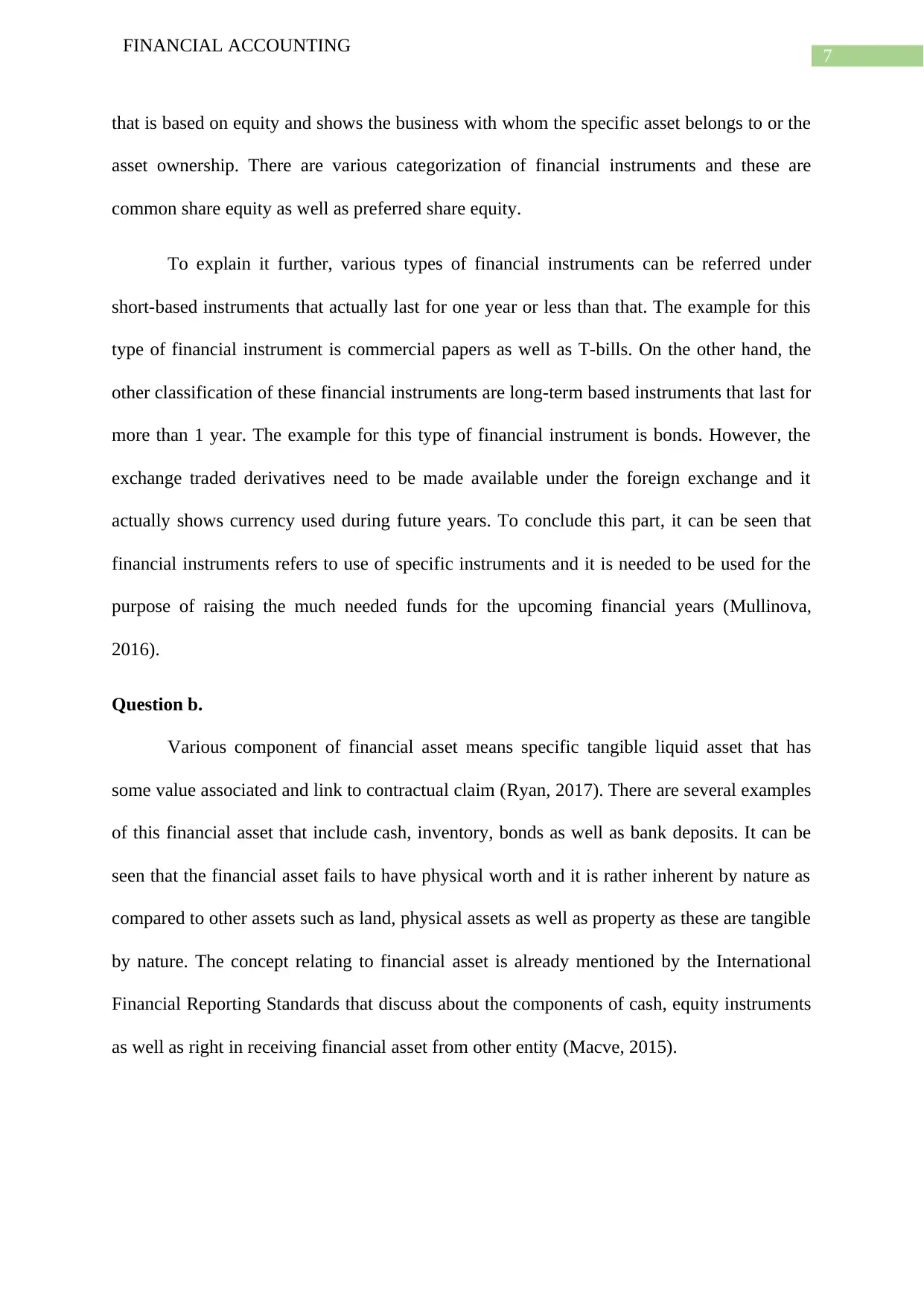
7
FINANCIAL ACCOUNTING
that is based on equity and shows the business with whom the specific asset belongs to or the
asset ownership. There are various categorization of financial instruments and these are
common share equity as well as preferred share equity.
To explain it further, various types of financial instruments can be referred under
short-based instruments that actually last for one year or less than that. The example for this
type of financial instrument is commercial papers as well as T-bills. On the other hand, the
other classification of these financial instruments are long-term based instruments that last for
more than 1 year. The example for this type of financial instrument is bonds. However, the
exchange traded derivatives need to be made available under the foreign exchange and it
actually shows currency used during future years. To conclude this part, it can be seen that
financial instruments refers to use of specific instruments and it is needed to be used for the
purpose of raising the much needed funds for the upcoming financial years (Mullinova,
2016).
Question b.
Various component of financial asset means specific tangible liquid asset that has
some value associated and link to contractual claim (Ryan, 2017). There are several examples
of this financial asset that include cash, inventory, bonds as well as bank deposits. It can be
seen that the financial asset fails to have physical worth and it is rather inherent by nature as
compared to other assets such as land, physical assets as well as property as these are tangible
by nature. The concept relating to financial asset is already mentioned by the International
Financial Reporting Standards that discuss about the components of cash, equity instruments
as well as right in receiving financial asset from other entity (Macve, 2015).
FINANCIAL ACCOUNTING
that is based on equity and shows the business with whom the specific asset belongs to or the
asset ownership. There are various categorization of financial instruments and these are
common share equity as well as preferred share equity.
To explain it further, various types of financial instruments can be referred under
short-based instruments that actually last for one year or less than that. The example for this
type of financial instrument is commercial papers as well as T-bills. On the other hand, the
other classification of these financial instruments are long-term based instruments that last for
more than 1 year. The example for this type of financial instrument is bonds. However, the
exchange traded derivatives need to be made available under the foreign exchange and it
actually shows currency used during future years. To conclude this part, it can be seen that
financial instruments refers to use of specific instruments and it is needed to be used for the
purpose of raising the much needed funds for the upcoming financial years (Mullinova,
2016).
Question b.
Various component of financial asset means specific tangible liquid asset that has
some value associated and link to contractual claim (Ryan, 2017). There are several examples
of this financial asset that include cash, inventory, bonds as well as bank deposits. It can be
seen that the financial asset fails to have physical worth and it is rather inherent by nature as
compared to other assets such as land, physical assets as well as property as these are tangible
by nature. The concept relating to financial asset is already mentioned by the International
Financial Reporting Standards that discuss about the components of cash, equity instruments
as well as right in receiving financial asset from other entity (Macve, 2015).
Paraphrase This Document
Need a fresh take? Get an instant paraphrase of this document with our AI Paraphraser
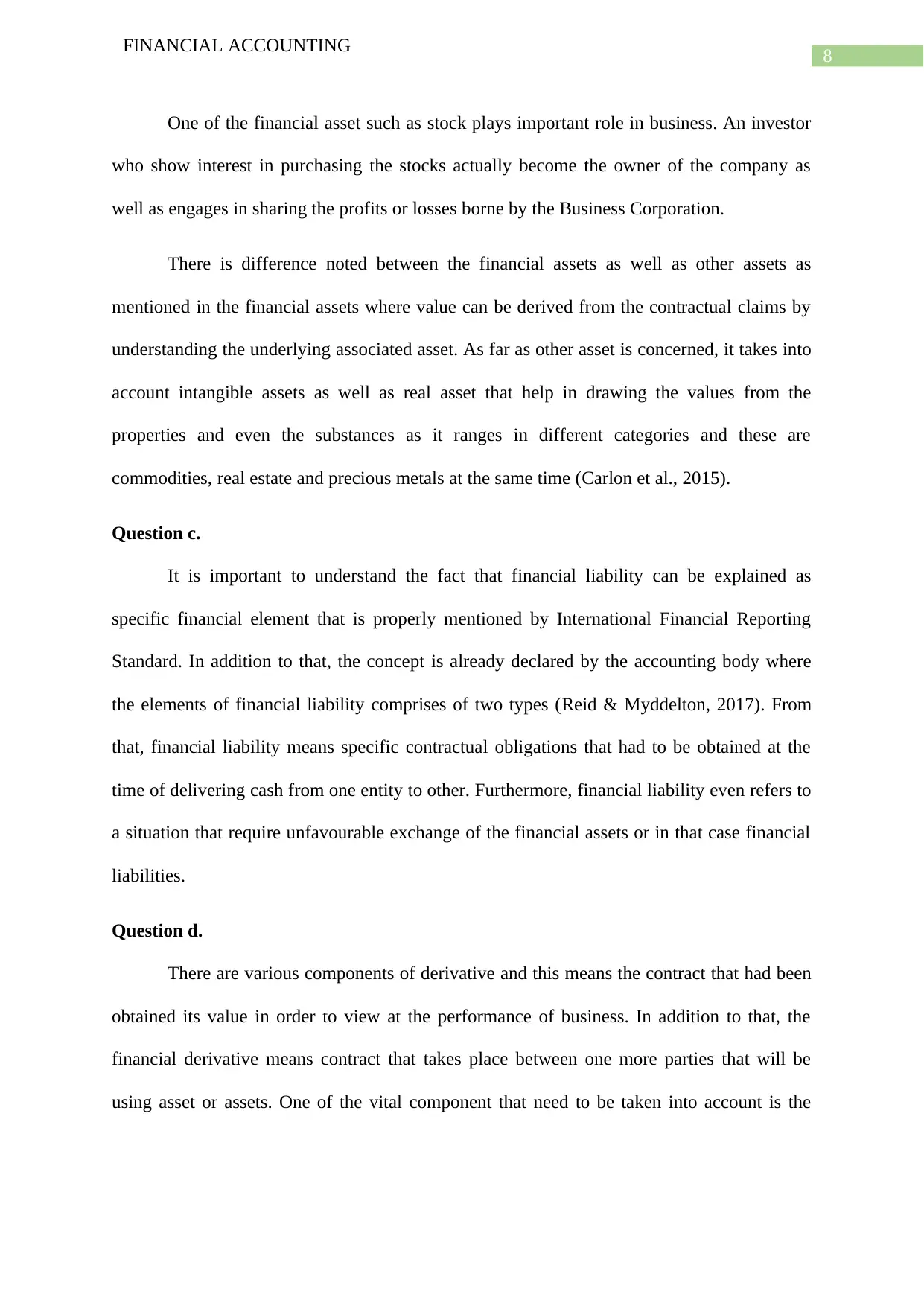
8
FINANCIAL ACCOUNTING
One of the financial asset such as stock plays important role in business. An investor
who show interest in purchasing the stocks actually become the owner of the company as
well as engages in sharing the profits or losses borne by the Business Corporation.
There is difference noted between the financial assets as well as other assets as
mentioned in the financial assets where value can be derived from the contractual claims by
understanding the underlying associated asset. As far as other asset is concerned, it takes into
account intangible assets as well as real asset that help in drawing the values from the
properties and even the substances as it ranges in different categories and these are
commodities, real estate and precious metals at the same time (Carlon et al., 2015).
Question c.
It is important to understand the fact that financial liability can be explained as
specific financial element that is properly mentioned by International Financial Reporting
Standard. In addition to that, the concept is already declared by the accounting body where
the elements of financial liability comprises of two types (Reid & Myddelton, 2017). From
that, financial liability means specific contractual obligations that had to be obtained at the
time of delivering cash from one entity to other. Furthermore, financial liability even refers to
a situation that require unfavourable exchange of the financial assets or in that case financial
liabilities.
Question d.
There are various components of derivative and this means the contract that had been
obtained its value in order to view at the performance of business. In addition to that, the
financial derivative means contract that takes place between one more parties that will be
using asset or assets. One of the vital component that need to be taken into account is the
FINANCIAL ACCOUNTING
One of the financial asset such as stock plays important role in business. An investor
who show interest in purchasing the stocks actually become the owner of the company as
well as engages in sharing the profits or losses borne by the Business Corporation.
There is difference noted between the financial assets as well as other assets as
mentioned in the financial assets where value can be derived from the contractual claims by
understanding the underlying associated asset. As far as other asset is concerned, it takes into
account intangible assets as well as real asset that help in drawing the values from the
properties and even the substances as it ranges in different categories and these are
commodities, real estate and precious metals at the same time (Carlon et al., 2015).
Question c.
It is important to understand the fact that financial liability can be explained as
specific financial element that is properly mentioned by International Financial Reporting
Standard. In addition to that, the concept is already declared by the accounting body where
the elements of financial liability comprises of two types (Reid & Myddelton, 2017). From
that, financial liability means specific contractual obligations that had to be obtained at the
time of delivering cash from one entity to other. Furthermore, financial liability even refers to
a situation that require unfavourable exchange of the financial assets or in that case financial
liabilities.
Question d.
There are various components of derivative and this means the contract that had been
obtained its value in order to view at the performance of business. In addition to that, the
financial derivative means contract that takes place between one more parties that will be
using asset or assets. One of the vital component that need to be taken into account is the
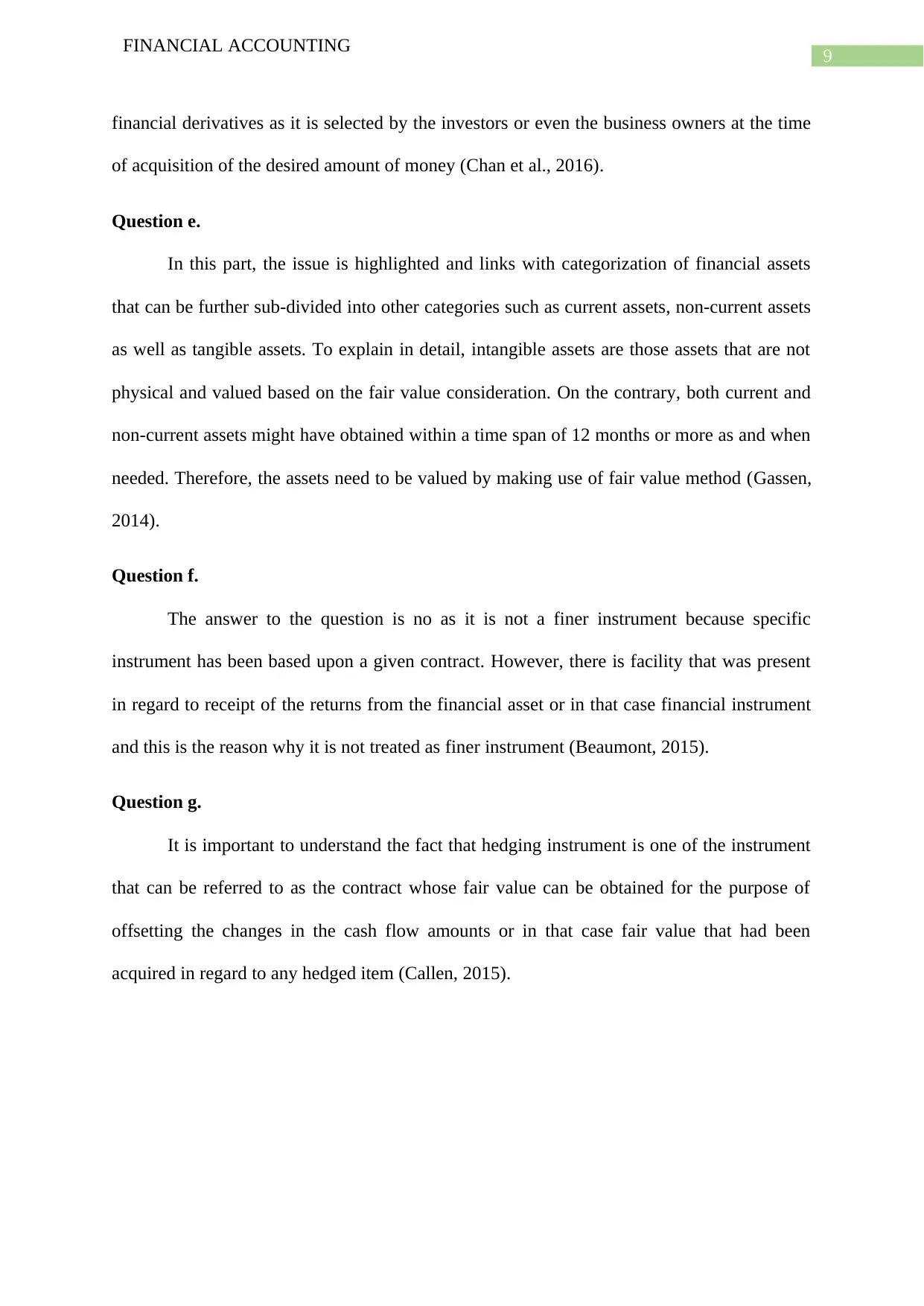
9
FINANCIAL ACCOUNTING
financial derivatives as it is selected by the investors or even the business owners at the time
of acquisition of the desired amount of money (Chan et al., 2016).
Question e.
In this part, the issue is highlighted and links with categorization of financial assets
that can be further sub-divided into other categories such as current assets, non-current assets
as well as tangible assets. To explain in detail, intangible assets are those assets that are not
physical and valued based on the fair value consideration. On the contrary, both current and
non-current assets might have obtained within a time span of 12 months or more as and when
needed. Therefore, the assets need to be valued by making use of fair value method (Gassen,
2014).
Question f.
The answer to the question is no as it is not a finer instrument because specific
instrument has been based upon a given contract. However, there is facility that was present
in regard to receipt of the returns from the financial asset or in that case financial instrument
and this is the reason why it is not treated as finer instrument (Beaumont, 2015).
Question g.
It is important to understand the fact that hedging instrument is one of the instrument
that can be referred to as the contract whose fair value can be obtained for the purpose of
offsetting the changes in the cash flow amounts or in that case fair value that had been
acquired in regard to any hedged item (Callen, 2015).
FINANCIAL ACCOUNTING
financial derivatives as it is selected by the investors or even the business owners at the time
of acquisition of the desired amount of money (Chan et al., 2016).
Question e.
In this part, the issue is highlighted and links with categorization of financial assets
that can be further sub-divided into other categories such as current assets, non-current assets
as well as tangible assets. To explain in detail, intangible assets are those assets that are not
physical and valued based on the fair value consideration. On the contrary, both current and
non-current assets might have obtained within a time span of 12 months or more as and when
needed. Therefore, the assets need to be valued by making use of fair value method (Gassen,
2014).
Question f.
The answer to the question is no as it is not a finer instrument because specific
instrument has been based upon a given contract. However, there is facility that was present
in regard to receipt of the returns from the financial asset or in that case financial instrument
and this is the reason why it is not treated as finer instrument (Beaumont, 2015).
Question g.
It is important to understand the fact that hedging instrument is one of the instrument
that can be referred to as the contract whose fair value can be obtained for the purpose of
offsetting the changes in the cash flow amounts or in that case fair value that had been
acquired in regard to any hedged item (Callen, 2015).
⊘ This is a preview!⊘
Do you want full access?
Subscribe today to unlock all pages.

Trusted by 1+ million students worldwide
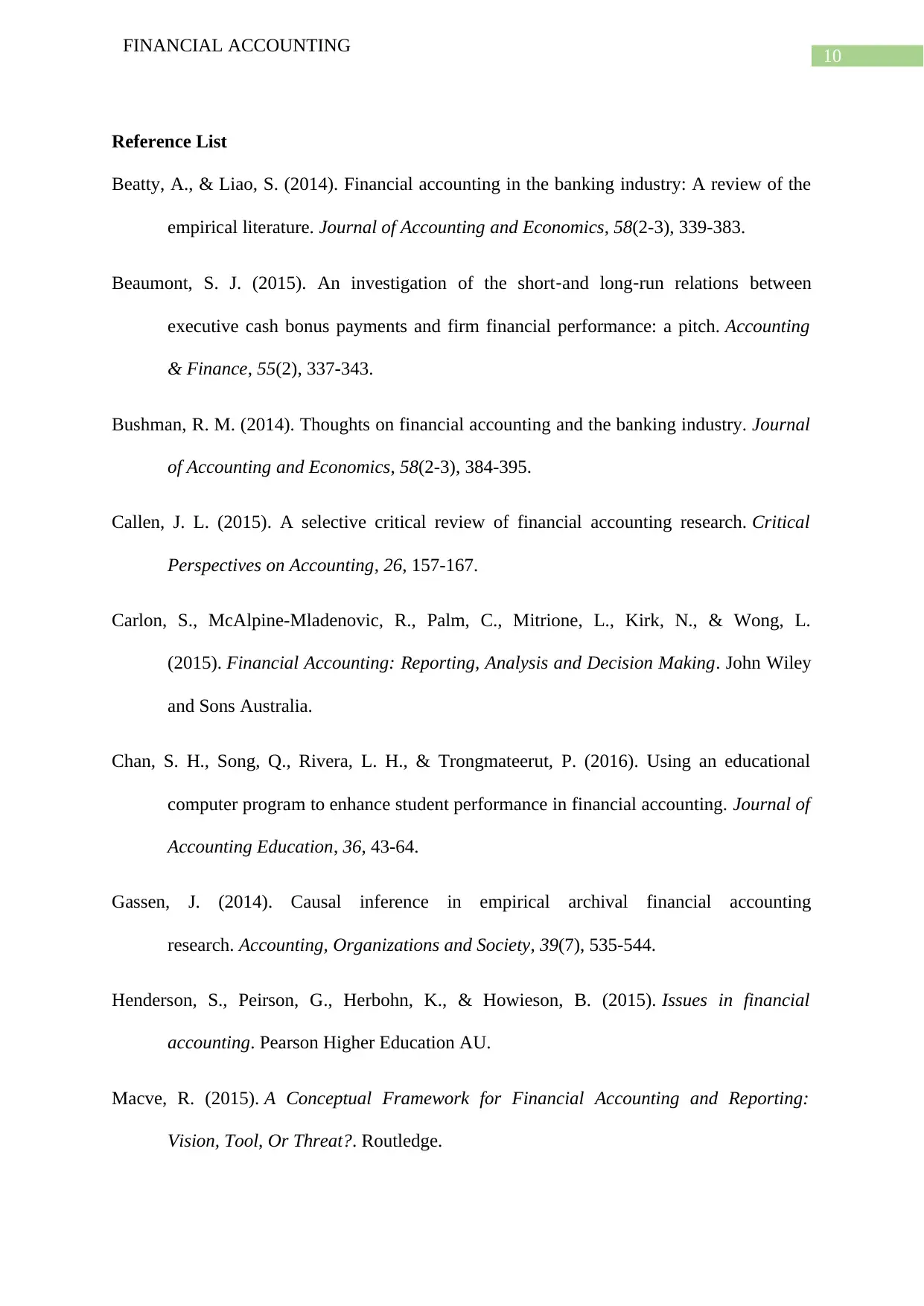
10
FINANCIAL ACCOUNTING
Reference List
Beatty, A., & Liao, S. (2014). Financial accounting in the banking industry: A review of the
empirical literature. Journal of Accounting and Economics, 58(2-3), 339-383.
Beaumont, S. J. (2015). An investigation of the short‐and long‐run relations between
executive cash bonus payments and firm financial performance: a pitch. Accounting
& Finance, 55(2), 337-343.
Bushman, R. M. (2014). Thoughts on financial accounting and the banking industry. Journal
of Accounting and Economics, 58(2-3), 384-395.
Callen, J. L. (2015). A selective critical review of financial accounting research. Critical
Perspectives on Accounting, 26, 157-167.
Carlon, S., McAlpine-Mladenovic, R., Palm, C., Mitrione, L., Kirk, N., & Wong, L.
(2015). Financial Accounting: Reporting, Analysis and Decision Making. John Wiley
and Sons Australia.
Chan, S. H., Song, Q., Rivera, L. H., & Trongmateerut, P. (2016). Using an educational
computer program to enhance student performance in financial accounting. Journal of
Accounting Education, 36, 43-64.
Gassen, J. (2014). Causal inference in empirical archival financial accounting
research. Accounting, Organizations and Society, 39(7), 535-544.
Henderson, S., Peirson, G., Herbohn, K., & Howieson, B. (2015). Issues in financial
accounting. Pearson Higher Education AU.
Macve, R. (2015). A Conceptual Framework for Financial Accounting and Reporting:
Vision, Tool, Or Threat?. Routledge.
FINANCIAL ACCOUNTING
Reference List
Beatty, A., & Liao, S. (2014). Financial accounting in the banking industry: A review of the
empirical literature. Journal of Accounting and Economics, 58(2-3), 339-383.
Beaumont, S. J. (2015). An investigation of the short‐and long‐run relations between
executive cash bonus payments and firm financial performance: a pitch. Accounting
& Finance, 55(2), 337-343.
Bushman, R. M. (2014). Thoughts on financial accounting and the banking industry. Journal
of Accounting and Economics, 58(2-3), 384-395.
Callen, J. L. (2015). A selective critical review of financial accounting research. Critical
Perspectives on Accounting, 26, 157-167.
Carlon, S., McAlpine-Mladenovic, R., Palm, C., Mitrione, L., Kirk, N., & Wong, L.
(2015). Financial Accounting: Reporting, Analysis and Decision Making. John Wiley
and Sons Australia.
Chan, S. H., Song, Q., Rivera, L. H., & Trongmateerut, P. (2016). Using an educational
computer program to enhance student performance in financial accounting. Journal of
Accounting Education, 36, 43-64.
Gassen, J. (2014). Causal inference in empirical archival financial accounting
research. Accounting, Organizations and Society, 39(7), 535-544.
Henderson, S., Peirson, G., Herbohn, K., & Howieson, B. (2015). Issues in financial
accounting. Pearson Higher Education AU.
Macve, R. (2015). A Conceptual Framework for Financial Accounting and Reporting:
Vision, Tool, Or Threat?. Routledge.
Paraphrase This Document
Need a fresh take? Get an instant paraphrase of this document with our AI Paraphraser
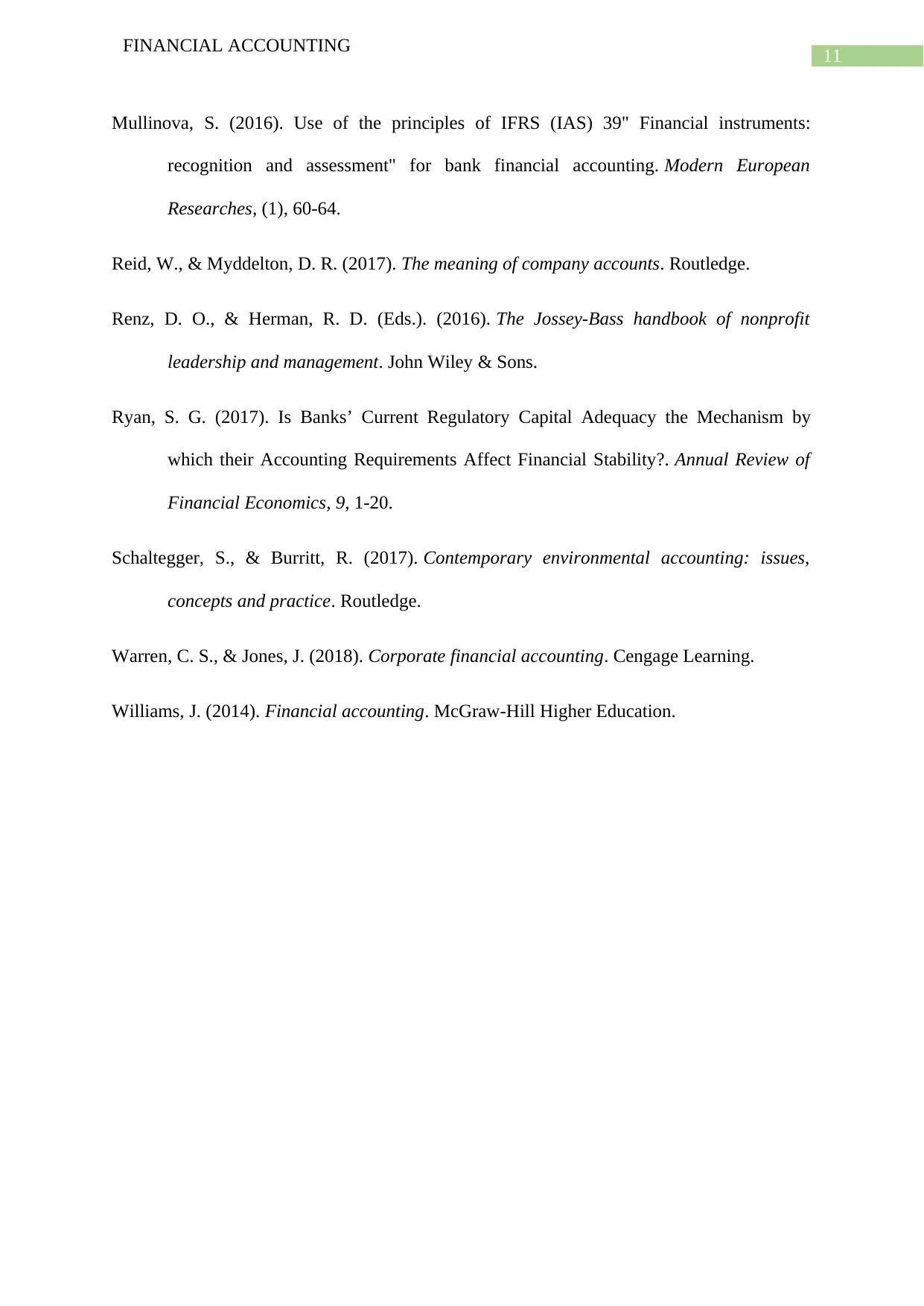
11
FINANCIAL ACCOUNTING
Mullinova, S. (2016). Use of the principles of IFRS (IAS) 39" Financial instruments:
recognition and assessment" for bank financial accounting. Modern European
Researches, (1), 60-64.
Reid, W., & Myddelton, D. R. (2017). The meaning of company accounts. Routledge.
Renz, D. O., & Herman, R. D. (Eds.). (2016). The Jossey-Bass handbook of nonprofit
leadership and management. John Wiley & Sons.
Ryan, S. G. (2017). Is Banks’ Current Regulatory Capital Adequacy the Mechanism by
which their Accounting Requirements Affect Financial Stability?. Annual Review of
Financial Economics, 9, 1-20.
Schaltegger, S., & Burritt, R. (2017). Contemporary environmental accounting: issues,
concepts and practice. Routledge.
Warren, C. S., & Jones, J. (2018). Corporate financial accounting. Cengage Learning.
Williams, J. (2014). Financial accounting. McGraw-Hill Higher Education.
FINANCIAL ACCOUNTING
Mullinova, S. (2016). Use of the principles of IFRS (IAS) 39" Financial instruments:
recognition and assessment" for bank financial accounting. Modern European
Researches, (1), 60-64.
Reid, W., & Myddelton, D. R. (2017). The meaning of company accounts. Routledge.
Renz, D. O., & Herman, R. D. (Eds.). (2016). The Jossey-Bass handbook of nonprofit
leadership and management. John Wiley & Sons.
Ryan, S. G. (2017). Is Banks’ Current Regulatory Capital Adequacy the Mechanism by
which their Accounting Requirements Affect Financial Stability?. Annual Review of
Financial Economics, 9, 1-20.
Schaltegger, S., & Burritt, R. (2017). Contemporary environmental accounting: issues,
concepts and practice. Routledge.
Warren, C. S., & Jones, J. (2018). Corporate financial accounting. Cengage Learning.
Williams, J. (2014). Financial accounting. McGraw-Hill Higher Education.
1 out of 11
Related Documents
Your All-in-One AI-Powered Toolkit for Academic Success.
+13062052269
info@desklib.com
Available 24*7 on WhatsApp / Email
![[object Object]](/_next/static/media/star-bottom.7253800d.svg)
Unlock your academic potential
Copyright © 2020–2025 A2Z Services. All Rights Reserved. Developed and managed by ZUCOL.





